
Pokémon Go is an AR game that shot to popularity in 2016, allowing users to see creatures from the game on their mobile phones in the player’s own environment
There are lots of amazing technologies now that can be used in the sign world to catapult an ordinary signage project into something truly unique. However, it is still important to know the differences between the sectors. In this feature, I will focus on augmented reality (AR), which adds interactive features to your current environment. You may also be familiar with virtual reality, which replaces your environment with a new landscape—think Oculus Rift and other headsets that make you feel like you somewhere completely different—but I will leave this topic to another day.
I can see why the technologies can get confused, which is why I have spoken to a handful of companies operating in this market—Holotronica, Seloy Live, UXG, Vivid Works, and JCDecaux—to find out what they define as augmented reality as each offers an exciting yet different approach.
Blurring the lines
Holotronica is the owner of Holo-Gauze, a 3D display solution for large hologram effects. After a quick look on its website, I can see that this effect is clearly breaking new ground and is ideal for large-scale events. In terms of signage, you could say it is a creative version of a wayfinding sign, and could certainly be used more to that effect in the future.
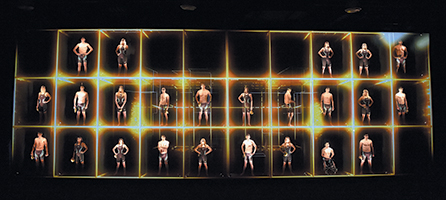
Holo-Gauze was used to create an augmented reality style grid for the launch of Team Speedo, featuring many hologram athletes
Founder and managing director of Holotronica, Stu Warren-Hill, explains his take on the sector: “AR is the process of enhancing or augmenting existing reality through the use of a display medium. Our display medium is invisible when used correctly and so the line between reality and augmented reality is a finer and less distinguishable one.
“We are working on different ways to create the AR experience using our invisible projection surface Holo-Gauze.
So rather than graphics being overlaid on a video screen it can be layered over a person on stage, there are various ways to track the performer and we have embarked on developing and providing the best solutions for this effect.”
Warren-Hill shares details of a visual music AR experience he created recently, where three toy characters appeared on people’s hands that held a card with the corresponding logo. He continues: “A toy monkey playing cymbals and two robots firing lasers and zap sounds. Three people could interact and bring the characters towards the TV monitor with a camera attached and the closer they got, the louder the toys playing became. A catchy electro tune was created and remixed by the three animated toys.”
Signlink has previously reported on Holo-Gauze being used during a Grammy Awards performance by Beyoncé and also at a DJ Eric Prydz concert. The company also produced an augmented reality style grid for the launch of Team Speedo, where athletes, and information such as their name and Olympic team, were revealed one by one through a near-invisible gauze.

I think in the long run AR will be embraced by the masses more than the currently solitary detached VR experience”
Warren-Hill believes AR will be in “everyday use” in the near future, as it becomes a more sophisticated piece of technology. He adds: “I think in the long run AR will be embraced by the masses more than the currently solitary detached VR experience. When content needs to be demonstrated or displayed or when someone is creative enough to develop an augmented environment that users can view individually or as a larger population then Holo-Gauze and our range of holographic solutions will be where everyone will look first.”
Window of opportunity
Seloy Live, an interactive glass manufacturer, is another exciting company in the field. Its Sense product is a combination of transparent glass and interactive touch surface, which allows passers-by to engage with interactive content during the day but functions as a regular window when switched off.
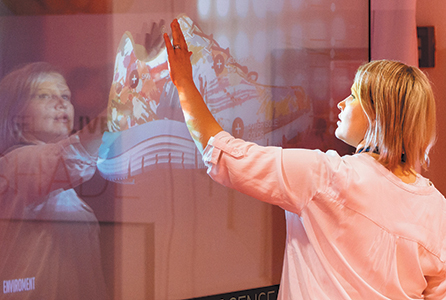
Seloy Live products, such as Sense, are a “perfect canvas for AR content”, says sales director Anne Lindgren
Anne Lindgren, sales director of Seloy Live, explains what AR means to her: “AR adds a glimpse of the future to our reality in a visual way. As artists always need a canvas for their skills, Seloy Live products are a perfect canvas for AR content, whether it’s touch-enabled or not. Every single product is built according to the specific needs the customers have, so they will have their own unique canvas to fit exactly the space they’d wish to add a bit of magic.”
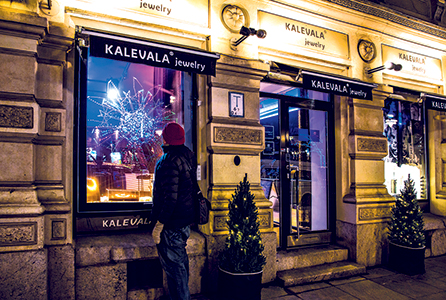
Seloy Live re-imagined Kalevala Jewelry’s store window with interactive glass
She goes on to share details of the first project Seloy Live made, which was for a Finnish jewellery company: “We re-imagined their flagship store front window with interactive glass. As it opened before Christmas, customers got to create their own unique snowflakes and share it on social media. We also delivered a solution for Paramount Pictures for their new futuristic film premier party. People have been curiously thrilled to see a touchable solution that is not a typical screen, rather a surface that would be there anyway, inviting people to become a part of the brand’s journey.”
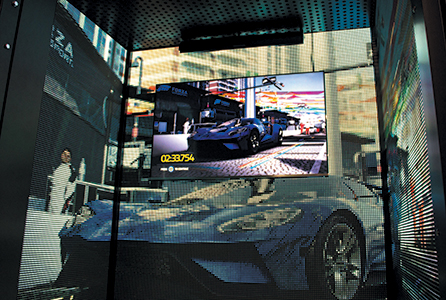
The Xbox One Gaming Pod was created by UXG, and used LED screens and surround sound for the ultimate gaming experience
In this example, simple signage such as a ‘SALE’ sign in a shop window is replaced with something much more interactive and fun. Shoppers are able to design their own pictures on the window and then share them on social media, which as a result could draw them into the store or catch the eye of their social media followers.
Lindgren believes ‘smart surfaces’ are the future. She comments: “As nearly everyone owns a smartphone and touch displays aren’t that rare, small children have been born into a world where they learn to use these devices before they learn to walk. Devices we use work with touch (phones, pads, laptops, remote controls for TVs, etc.), and these aren’t a luxury anymore so the next logical step is to make smart surfaces instead of trying to mask displays into things.
O Factoid: AR game Pokémon Go became the most downloaded mobile app in its first week of release in the history of the App Store, with some websites reporting download numbers of 15 million during this period. O
“Having worked with touch technology for years, the response people still have for bigger touch-enabled products than their phones is, ‘wow, this is like Minority Report’, referring to the famous Tom Cruise movie. They just don’t yet realise that it’s already a reality, not a faked movie scene. AR will become a necessity instead of a nice to have, flashy (and pricy) thing.”
Opening avenues
Another key AR player is Unicam Digital Group, which rebranded as UXG (User Experience Global) following its last year of growth, resulting in a move to a new 14,000sq f headquarters near the centre of Leeds that doubled its build space. The company delivers LED walls, including interactive walls and tables.
Drew Dooler, managing director of UXG, explains how he thinks AR is “game changing technology”, saying: “It’s the next step in fusing the real world with the digital and it’s only now just starting to truly find its place in our day to day lives, opening up an unprecedented amount of avenues for creatives in all fields.
“We are always looking to create new exciting innovative ways for our clients to engage with their customers, AR is another area we’ve been further developing to deliver in. We’ve been looking at creating dynamic and engaging content that can open up new innovative ways of connecting with your target audience. By delivering information in real time and in a semantic context, we can now enhance so many experiences that before were just unheard of or thought impossible.”
He goes on to talk about the future of the industry: “The AR industry is a multi-billion-dollar industry, just last year the market was valued at $117bn (around £88bn). We’re still yet to see a larger adoption into the mainstream, but already we’re seeing new project briefs and ideas coming through wanting to explore and implement AR. I’ve no doubt that the AR market will continue to grow exponentially as more and more companies start to implement it into new marketing campaign strategies, advertising, for training purposes and even ways to make our day to day easier.
“It’s got so much potential to work in many different mediums with a limited amount of implementation on the end user’s part. It could be as simple as a smartphone app and a movie poster in a cinema’s atrium, from there you could have links to trailers, competitions or even the film star standing right in front of you. Imagine an information display with real time information that can overlay right into the real world.
“We’ve seen mobile apps use this technology and take the world by storm, particularly a game last year that propelled this technology straight into the mainstream, creating an understanding of its capabilities. I say this is an exciting and very interesting sector that shouldn’t be overlooked by anyone in this industry as it’s now just starting to come into its own.”
Vivid Works is another expert in AR, with its Vivid AR product which ‘shows virtual products in real space’ and offers ‘a lifelike try before you buy experience’.
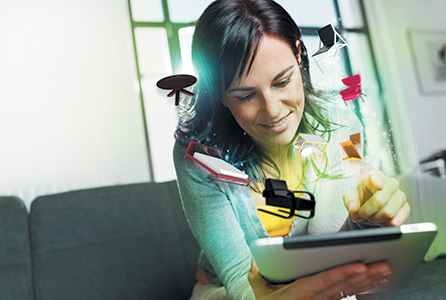
Vivid Works’ Live Design product uses AR to show, for example, how a particular sofa would look in your house
Jorma Palo, chief operating officer of Vivid Works, comments: “With AR technology we let users combine real space and virtual products—in practice users get a real life impression of how products (and any combination of products) will fit into a real world environment.
“One of latest customer cases has been to bring B2B business solution for sales team use—visual configuration combined with an AR approach. Lindström is a very good and successful recent example.”
Textile services provider Lindström Group runs a rental mat service to suit what clients need for their corporate style. However, there is a large range of mats and it can be hard to visualise how it will look in a company’s premises. The company offered hotel Scandic Oulu a chance to see, with Live Design from Vivid Works, what the mats would look like in the planned places. Live Design uses AR to show images of the products in a real environment.
This can certainly be applied to the sign industry, with brands opting to use AR to see exactly how different types of signs would look on the shop front, for example.
Palo adds: “For sure AR will bring huge benefits for multiple industries, allowing users to try and visualise products in real environments. Vivid Works combines visual configuration seamlessly with AR in a new exciting way to buy and sell products.”
AR is a definitely an appealing technology and can be used in so many creative ways, as highlighted above. What will be interesting to see now is if AR will become a more mainstream part of the sign industry, and with what I have seen through researching this feature, I hope it does.
Your text here...